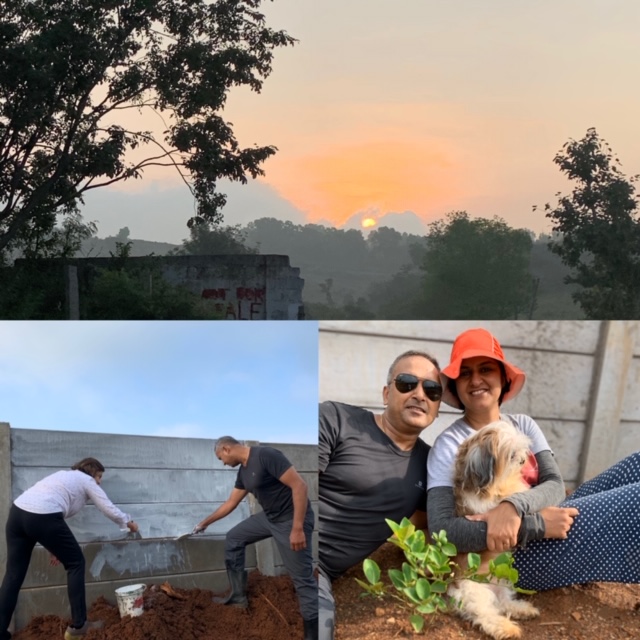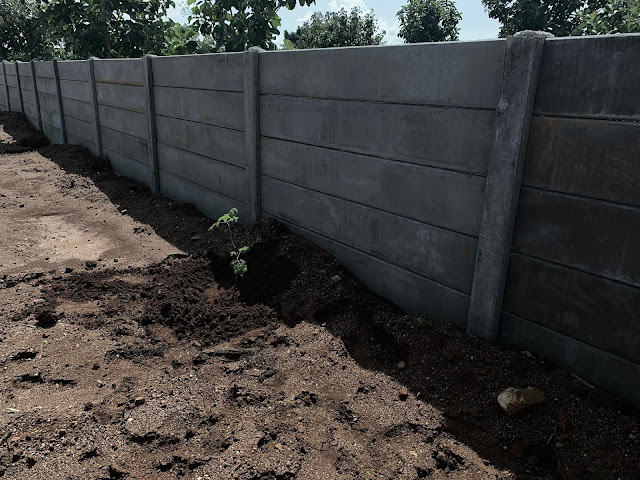Oct - Week 1
This week ended with a long weekend and my husband and I could spend some extra time on the farm. I wanted to make raised beds and get those ready, but couldn't get that part of the work finished. In fact we could get it started either. We still don't have electricity on our farm so we are having to go a bit slow right now. Hopefully, that should come in a couple of months.
We had to clear all the trees on the land to level it initially and now I feel it looks really sad. I wanted to cover it with fruit trees to make it look a little better in my words ... a bit happier 😊😊.
So a couple of weeks back we planted our first Chikoo tree and Guava tree and then this week we planted some Moringa plants, Curry leaves plant, two lemon trees, and four Papaya saplings. I have used organic compost until now while planting. The ratio is 50-50. 50% soil and 50%
organic compost.
There are quite a few different ways to make organic compost and a number of videos shared by organic gardeners on how to make that. I have added a link above that could possibly help you.
I picked up Red lady variety of Papaya saplings. This is a Thai variety of Papaya. Have planted them for the first time so let's see how they do. As a thumb rule about 15-20 cm. tall seedlings are planted during spring (February-March), monsoon (June-July) and autumn (October-November). To know more about the best season and soil information can be got from the National Horticulture Board
In case you have any suggestions on improving Papaya growth organically please do share your thoughts in the comments below.
We also planted the Stevia shrubs we got a couple of weeks back. Made a makeshift shed for them in one of the far corners of the farm. Stevia is another super herb and beneficial to people suffering from Diabetes or looking at reducing sugar in order to lose weight. It is used extensively as an alternative to sugar. There are a lot of alternatives in the market today like dates sugar and cocopalm sugar, and Stevia is one of them. You can either buy ready-made Stevia powder off the shelf or dry leaves from Stevia plant in the shade and make your own powder. But be sure to check with your doctor before using natural Stevia. If you are keen on cultivating Stevia on a large scale there is a lot of help available online.
We used some green net cloth of the shed and two strong branches for support. The green net coth would project the newly planted Stevia shrubs from the sun and the rain.
While the major part of the cultivation is still something we are planning, I am trying to include fruits and herbs which have health benefits. We will use these for our selves as well as for barter.
You can see the damage the rain has done to our newly constructed wall. The flow of water was so strong that it pushes the mud on the other side through the wall. This will be redone as soon as the rains settle down a bit.
The sun is very strong when it isn't raining so I covered the seedlings with big Oak leaves to protect them. And of course you can see Bogie inspecting my work again.
After all the hard work we decided to rest a bit under the shade. The weather is beautiful. We set up our tents and opened up our picnic basket.
Sept Week 4
Its been raining really hard so this week we couldn't get anything done. Rain is totally welcome. Need it for the underground water beds to get recharged. The pathway to our farm was completely flooded.
Sept Week 3
Wow today was one incredible day. Since we get to spend only a few hours per week on the farm we try to fit in as much as possible. So this week we had planned to doing some primer on the walls as well as hunt for the right nursery.
We found an amazing
nursery where I could find some of the fruit trees I really wanted as well as some other plants I was looking for. They have acres and acres of amazing plants. I picked up a couple of Dragon fruit plants, Passion fruit, Red Lady Papaya, Lemon, Moringa and Curry leaves to start with. We also got a couple of Stevia shrubs.
I was looking for a creeper variety of Rose which I wanted to plant at the main gate of the farm but couldn't get those yet.
 Aug - 2019 Week 4
Aug - 2019 Week 4 The walls are done and we planted our first fruit trees- Chikcoo and white-centered guava. And we have Bogie inspecting if I did it right
 |
Chikoo tree plantation
|
Aug Week 3 We found a stream not very far from our farmland ... it’s a trek away
 Aug Week 2
Aug Week 2
We started installing a compound wall around the land to avoid cattle from coming in. We had to get help from local workers to fit in the slabs. Our options were either building a brick wall or working with prefabricated ones. Opted for pre-fabricated walls. They are quicker to install and can be done really fast.
We cemented the pillars so that they hold strong. Of course Bogie was part of the excitement and fell into the pits dugout for the pillars a couple of times.
Hello peepa ... sharing our story about our latest DIY project —- getting our farmland up and running( not the typical big traditional farm but rather a small piece of land). Something we purchased almost 12 years ago but didn’t have the time to work on. We are building it our selves piece by piece and would be glad to get your comments or suggestions as to along. Neither of us is from a farming background. Sharing a few pics of what it was 4 months back to now.
We have our regular day jobs which we manage through the weekday and run off to the farm over the weekend. It has been a shift from looking forward to our typically parting-with-friends over the weekend to working-on-the-farm over the weekend.
Overgrown and wild ... that’s how it was 4 months back
We started the clearing work. We leveled the ground.
Our little Shishtzu - Bogie is super excited to be here ... more excited were the crows. They are used to seeing farm cows and sheep’s much bigger than lil bogie and couldn’t help wonder what this tiny four-legged creature was! This little dog child of ours has been having a lot of fun running around

























